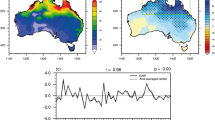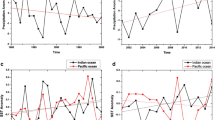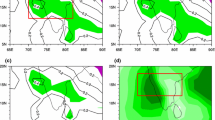Abstract
While the El Niño-Southern Oscillation and Indian Summer Monsoon Rainfall (ISMR) relationship is weak in recent years, a strong correlation between May Southern Annular Mode Index (SAMI) and June–July (JJ) ISMR is a southern hemispheric source of ISMR predictability. Here, using observed and reanalysis data, we find that the SAMI–ISMR relationship is non-stationary with a potential multi-decadal variability. Both during high/low correlation periods (1980–2010)/(1949–1979), a Southern Indian Ocean Dipole (SIOD) pattern of JJ sea surface temperature anomaly is found to reverse sign during strong and weak SAMI years. The changes in the strength and location of the northern pole of SIOD during the two time blocks are consistent with corresponding changes in the cross equatorial flow and monsoon south-westerlies together with change in SAMI–ISMR correlations. Our analysis indicates teleconnection pathways through which the Atlantic Multidecadal Oscillation (AMO) may be responsible for the multi-decadal swings of SAMI–ISMR correlations through modulation of the SIOD.







Similar content being viewed by others
References
Ajayamohan RS, Rao SA, Yamagata T (2008) Influence of Indian Ocean Dipole on poleward propagation of boreal summer intraseasonal oscillations. J Clim 21:5437–5454
Bamzai AS, Shukla J (1999) Relation between Eurasian snow cover, snow depth, and the Indian summer monsoon: an observational study. J Clim 12:3117–3132
Borah P, Venugopal V, Sukhatme J, Muddebihal P, Goswami BN (2019) Role of the North Atlantic in Indian monsoon droughts. https://arxiv.org/abs/1911.10013
Charney JG, Shukla J (1981) Predictability of monsoons. In: Lighthill J, Pearce RP (eds) Monsoon dynamics. Cambridge University Press, Cambridge, pp 99–108
Compo GP et al (2011) The twentieth century reanalysis project. Q J R Meteorol Soc 137:1–28. https://doi.org/10.1002/qj.776
Dou J, Wu Z, Zhou Y (2017) Potential impact of the May Southern Hemisphere annular mode on the Indian summer monsoon rainfall. Clim Dyn 49:1257–1269
Dugam SS, Kakade SB, Verma RK (1997) Interannual and long-term variability in the North Atlantic Oscillation and ISM rainfall. Theor Appl Climatol 58:21–29
Gong D, Wang S (1999) Definition of Antarctic Oscillation Index. Geophys Res Lett 26:459–462
Goswami BN, Madhusoodanan MS, Neema CP, Sengupta D (2006) A physical mechanism for North Atlantic SST influence on the Indian Summer Monsoon. Geophys Res Lett 33:L02706. https://doi.org/10.1029/2005GL024803
Haustein K, Allen MR, Forster PM et al (2017) A real-time global warming index. Sci Rep 7:15417. https://doi.org/10.1038/s41598-017-14828-5
Huang B et al (2017) Extended reconstructed sea surface temperature version 5 (ERSSTv5), upgrades, validations, and intercomparisons. J Clim 30:8179–8205
Jain S, Scaife AA, Mitra AK (2019) Skill of Indian Summer Monsoon rainfall prediction in multiple seasonal prediction systems. Clim Dyn 52:5291–5301
Kang I-S, Shukla J (2006) Dynamic seasonal prediction and predictability of the monsoon. In: Wang B (ed) The Asian monsoon. Springer, Berlin, pp 585–612
Kothawale DR, Rajeevan M (2017) Monthly, seasonal and annual rainfall time series for all-India, homogeneous regions and meteorological subdivisions: 1871–2016. IITM research report, RR-138
Kripalani RH, Kulkarni A (1999) Climatology and variability of historical Soviet snow depth data: some new perspectives in snow-Indian monsoon teleconnections. Clim Dyn 15:475–489
Kripalani RH, Singh SV, Vernekar AD, Thapliyal V (1996) Empirical study on Numbus-7 snow mass and Indian Summer Monsoon rainfall. Int J Climatol 16:23–34
Kripalani RH, Kulkarni A, Sabade SS (2001) El Nino southern oscillation, Eurasian snow cover and the Indian monsoon rainfall. Proc Indian Natl Sci Acad 67A:361–368
Krishnamurthy V, Goswami BN (2000) Indian monsoon–ENSO relationship on interdecadal timescales. J Clim 13:579–595
Krishnamurthy L, Krishnamurthy V (2014) Influence of PDO on South Asian summer monsoon and monsoon–ENSO relation. Clim Dyn 42:2397–2410
Krishnamurthy L, Krishnamurthy V (2016) Teleconnections of Indian monsoon rainfall with AMO and Atlantic tripole. Clim Dyn 46:2269–2285
Krishnan R, Sugi M (2003) Pacific decadal oscillation and variability of the Indian Summer Monsoon rainfall. Clim Dyn 21:233–242
Kucharski F, Bracco A, Yoo J, Molteni F (2008) Atlantic forced component of the Indian monsoon interannual variability. Geophys Res Lett. https://doi.org/10.1029/2007GL033037
Kumar KK, Rajagopalan B, Hoerling M, Bates G, Cane M (2006) Unraveling the mystery of Indian Monsoon Failure during El Niño. Science 06 314(5796):115–119
Li X, Gerber EP, Holland DM, Yoo C (2015) A Rossby wave bridge from the tropical Atlantic to West Antarctica. J Climate 28:2256–2272
Luo F, Li S, Furevik T (2011) The connection between the Atlantic Multidecadal Oscillation and the Indian Summer Monsoon in Bergen Climate Model Version 2.0. J Geophys Res Atmos 116:1–9. https://doi.org/10.1029/2011JD015848
Malik A, Brönnimann S (2018) Factors affecting the inter-annual to centennial timescale variability of Indian Summer Monsoon rainfall. Clim Dyn 50:4347–4364
Malik A, Brönnimann S, Stickler A et al (2017) Decadal to multi-decadal scale variability of Indian Summer Monsoon rainfall in the coupled ocean-atmosphere-chemistry climate model SOCOL-MPIOM. Clim Dyn 49:3551–3572
Marini C, Frankignoul C, Mignot J (2011) Links between the Southern Annular Mode and the Atlantic meridional overturning circulation in a climate model. J Clim 24:624–640
Marshall GJ (2003) Trends in the Southern Annular Mode from observations and reanalyses. J Clim 16:4134–4143
Navarra A, Simoncini V (2010) A guide to empirical orthogonal functions for climate data analysis. Springer, New York. https://doi.org/10.1007/978-90-481-3702-2 (ISBN 9789048137015)
Okumura YM (2012) Decadal-interdecadal climate variability over antarctica and linkages to the tropics: analysis of ice core, instrumental, and tropical proxy data. J Clim 25:7421–7441
Pal J, Chaudhuri S, Roychowdhury A, Basu D (2017) An investigation of the influence of the southern annular mode on Indian Summer Monsoon rainfall. Met Apps 24:172–179. https://doi.org/10.1002/met.1614
Pandey P, Dwivedi S, Goswami BN, Kucharski F (2020) A new perspective on ENSO–Indian Summer Monsoon rainfall relationship in a warming environment. Clim Dyn 55:3307–3326
Parthasarathy B, Munot AA, Kothawale DR (1994) All-India monthly and seasonal rainfall series: 1871–1993. Theor Appl Climatol 49:217–224
Poli P et al (2016) ERA-20C: an atmospheric reanalysis of the twentieth century. J Clim 29:4083–4097
Prabhu A, Kripalani RH, Preethi B, Pandithurai G (2016) Potential role of the February–March Southern Annular Mode on the Indian Summer Monsoon rainfall: a new perspective. Clim Dyn 47:1161–1179
Preethi B, Kripalani RH, Krishna Kumar K (2010) Indian Summer Monsoon rainfall variability in global coupled ocean–atmospheric models. Clim Dyn 35:1521–1539
Rajeevan M, Unnikrishnan CK, Preethi B (2012) Evaluation of the ENSEMBLES multi-model seasonal forecasts of Indian Summer Monsoon variability. Clim Dyn 38:2257–2274
Rajesh PV, Goswami BN (2020) Four-dimensional structure and sub-seasonal regulation of the Indian Summer Monsoon multi-decadal mode. Clim Dyn. https://doi.org/10.1007/s00382-020-05407-y
Rao KG, Goswami BN (1988) Interannual variations of sea surface temperature over the Arabian Sea and the Indian monsoon: a new perspective. Mon Wea Rev 116:558–568
Sabeerali CT, Ajayamohan RS, Bangalath HK, Chen N (2019) Atlantic Zonal Mode: an emerging source of Indian summer monsoon variability in a warming world. Geophys Res Lett 46:4460–4467
Saha SK, Hazra A, Pokhrel S, Chaudhari HS, Sujith K, Rai A et al (2019) Unraveling the mystery of Indian Summer Monsoon prediction: improved estimate of predictability limit. J Geophys Res Atmos 124:1962–1974
Saji NH, Goswami BN, Vinayachandran PN, Yamagata T (1999) A dipole mode in the tropical Indian Ocean. Nature 401:360–363
Schneider U et al (2017) Evaluating the hydrological cycle over land using the newly-corrected precipitation climatology from the Global Precipitation Climatology Centre (GPCC). Atmosphere 8(3):52. https://doi.org/10.3390/atmos8030052
Shukla J (1975) Effect of Arabian sea-surface temperature anomaly on Indian summer monsoon: a numerical experiment with the GFDL mode. J Atmos Sci 32:503–511
Slivinski LC, Compo GP, Whitaker JS et al (2019) Towards a more reliable historical reanalysis: improvements for version 3 of the twentieth century reanalysis system. Q J R Meteorol Soc 145:2876–2908
Syed FS, Yoo JH, Körnich H, Kucharski F (2012) Extratropical influences on the inter-annual variability of South-Asian Monsoon. Clim Dyn 38:1661–1674
Visbeck M (2009) A station-based southern annular mode index from 1884 to 2005. J Clim 22(4):940–950. https://doi.org/10.1175/2008JCLI2260.1
Wang Y, Li S, Luo D (2009) Seasonal response of Asian monsoonal climate to the Atlantic Multidecadal Oscillation. J Geophys Res 114:D02112. https://doi.org/10.1029/2008JD010929
Wang Z, Zhang X, Guan Z, Sun B, Yang X, Liu C (2015) An atmospheric origin of the multi-decadal bipolar seesaw. Sci Rep 5:8909. https://doi.org/10.1038/srep08909
Xavier PK, Marzin C, Goswami BN (2007) An objective definition of the Indian summer monsoon season and a new perspective on ENSO–monsoon relationship. Q J Meteorol Soc 133:749–764
Yatagai A, Kamiguchi K, Arakawa O, Hamada A, Yasutomi N, Kitoh A (2012) APHRODITE: constructing a long-term daily gridded precipitation dataset for Asia based on a dense network of rain gauges. Bull Am Meteorol Soc 93(9):1401–1415
Zhang R, Delworth TL (2006) Impact of Atlantic multidecadal oscillations on India/Sahel rainfall and Atlantic hurricanes. Geophys Res Lett. https://doi.org/10.1029/2006GL026267
Acknowledgements
Authors are thankful to three anonymous reviewers whose comments and suggestions have helped us to improve the overall quality of the manuscript. SD thanks the DST for providing support under the DST-FIST scheme. PP thanks DST-CCP for providing research fellowship. BNG thanks the Science and Engineering Research Board, Government of India for the SERB Distinguished Fellowship and Cotton University for hosting. All the data used for the analysis in the paper are duly cited in the references. Datasets for this research are freely available and are reported in these in-text data citation references: ISMR data in Parthasarathy et al. (1994) and Kothawale and Rajeevan 2017; MSLP and wind data in Poli et al. (2016), Compo et al. (2011) and Slivinski et al. (2019); Marshall SAM index in Marshall (2003); GPCC precipitation data in Schneider et al. (2017) and SST data in Huang et al. (2017).
Author information
Authors and Affiliations
Corresponding author
Additional information
Publisher's Note
Springer Nature remains neutral with regard to jurisdictional claims in published maps and institutional affiliations.
Supplementary Information
Below is the link to the electronic supplementary material.
Rights and permissions
About this article
Cite this article
Dwivedi, S., Pandey, P. & Goswami, B.N. Nonstationarity and potential multi-decadal variability in Indian Summer Monsoon Rainfall and Southern Annular Mode teleconnection. Clim Dyn 59, 671–683 (2022). https://doi.org/10.1007/s00382-022-06146-y
Received:
Accepted:
Published:
Issue Date:
DOI: https://doi.org/10.1007/s00382-022-06146-y




